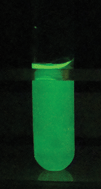A new blue-shifted luciferase from the Brazilian Amydetes fanestratus (Coleoptera: Lampyridae) firefly: molecular evolution and structural/functional properties
Abstract
Firefly luciferases usually produce bioluminescence in the yellow-green region, with colors in the green and yellow-orange extremes of the spectrum being less common. Several firefly luciferases have already been cloned and sequenced, and site-directed mutagenesis studies have already identified important regions and residues for bioluminescence colors. However the structural determinants and mechanisms of bioluminescence colors turned out to be elusive, mainly when comparing luciferases with a high degree of divergence. Thus comparison of more similar luciferases producing colors in the two extremes of the spectrum could be revealing. The South-American fauna of fireflies remains largely unstudied, with some unique taxa that are not found anywhere else in the world and that produce a wide range of bioluminescence colors. Among them, fireflies of the genus Amydetes are especially interesting because its taxonomical status as an independent subfamily or as a tribe is not yet solved, and because they usually produce a continuous bright blue-shifted bioluminescence. In this work we cloned the cDNA for the luciferase of the Atlantic rain forest Amydetes fanestratus firefly, which is found near Sorocaba municipality (São Paulo, Brazil). Despite showing a higher degree of identity with the South-American Cratomorphus, the European Lampyris and the Asiatic Pyrocoelia, phylogenetical analysis of the luciferase sequence support the inclusion of Amydetes as an independent subfamily. Amydetesluciferase displays one of the most blue-shifted


 Please wait while we load your content...
Please wait while we load your content...